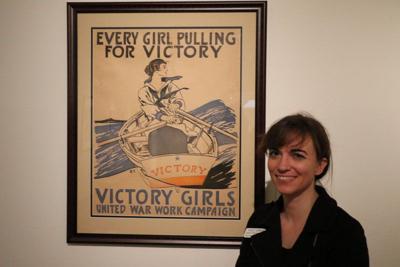It’s unusual for an art museum show to focus on much more than the selected work of one artist or school of artistry.
“Fine Print! Posters from the Permanent Collection” ambitiously scrutinizes imagery involving propaganda, popular culture, advertising, fine art and corporate responsibility by a host of artists and graphic designers. It’s currently on display through May 27 in the Ellen and Richard L. Sandor Photography Gallery in the University of Oklahoma’s Fred Jones Jr. Museum of Art.
Eugene B. Adkins Assistant Curator Hadley Jerman curated the exhibition and recently led a gallery talk about it.
Many of these posters have never been exhibited to the public before and it’s been over 50 years since the museum has hosted a major poster show. Curating it posed some unique challenges for Jerman.
“It’s a very wide ranging collection and finding some way of connecting these images together other than the fact that they’re all posters was tricky,” she said. “It seemed to work best set up in a loosely chronological and slight thematic arrangement. There are some gaps in our collection which made it more difficult.”
Jerman turned those thorny snags to the show’s advantage, however.
She pulled together a collection of imagery that’s stunning in no small part because the individual posters don’t necessarily have much in common. An oversized and spectacular 1897 poster promoting a European exposition competes for viewers’ attention with more modern ones from the 1972 Olympic Games. The fact that OU has been in possession of these works for decades but they’re unfamiliar makes the show a revelation. Some of the artists are prominent Art Deco designers and others virtually unknown and the details surrounding many have been obscured by time.
“In many cases we had no information about these posters,” Jerman said. “Some of the older ones have never been exhibited and we didn’t have artist names, just dates.”
Jerman and the registration department examined all 150 posters in the museum’s collection. Most were stored in flat files and some in photo storage. Gathering background information on some took over a year. She had help from outside the museum. The kind you’d expect at a major university.
“There’s a poster in the show that commemorates the 1917 Russian Revolution,” she said. “The words are in Cyrillic which I can’t read. The name we had in the records for the artist was completely misspelled and the date was off by 50 years. But thankfully assistant professor of Russian language Emily Johnson translated the poster and found information about that specific artist, which I couldn’t have done.
“Some of these posters are so fragile and large that I had to be cautious just pulling them out of the drawer. Some just couldn’t be exhibited because of their condition.”
Among the more notable pieces in the show are seven serigraphs in fine condition by Louis B. Siegriest (1899-1989) promoting the Indian Court art exhibition at San Francisco’s 1939 Golden Gate International Exposition. They are large, bright and bold, interpretive of traditional Native American imagery that would have been featured in the show.
“Siegriest was a member of the Society of Six that was an impressionist painting group in 1920s California,” Jerman said. “In the 1930s he got back into poster design and was hired by the Work Projects Administration to create this series of posters.”
The show’s WWI posters are on loan from OU’s Western History Collection. Their intent was to stir patriotism, inspire the purchase of war bonds and bolster morale on the home front. Over 100 years later the pictures retain a compelling quality.
“The French posters tended to encourage empathy in viewers while the American ones were about heroics,” Jerman said.
Jerman is particularly fond of what some might consider an unlikely choice for an art show. It’s a mid-20th century poster depicting General Atomic’s TRIGA series research-grade nuclear reactor. The picture is rendered in Pacific blues with an attractive orb-and-line-based design. Its vibe is decidedly futuristic.
“This is a really interesting poster,” Jerman said. “As a former designer I like the task artists had of creating an image of something dangerous that you can make approachable and non-threatening.”




















Commented
Sorry, there are no recent results for popular commented articles.